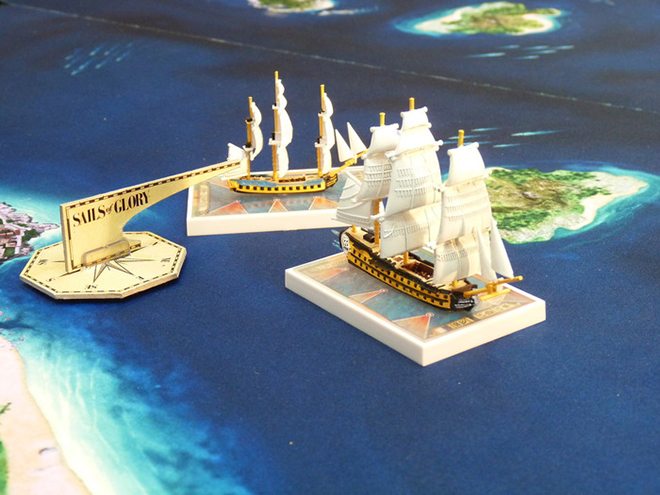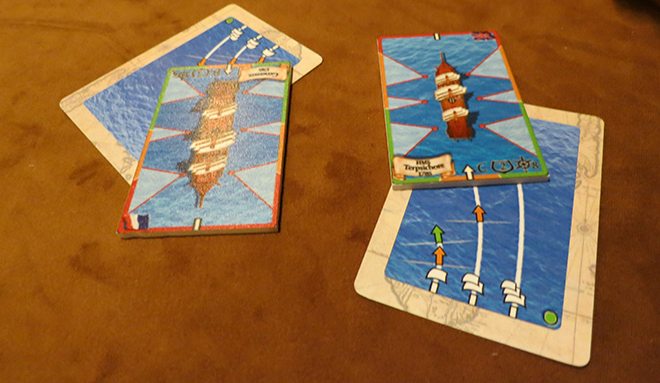
Life at sea during the Age of Sail was incredibly harsh. Cut off from shore for months at a time, sailors faced brutal living conditions, rotting and horrible food, and cruel punishment. On top of that, disease, the ocean, and even fellow shipmates threw up daily challenges to simply staying alive. Still, it was a romantic time and one of great exploration and adventure. And now, it’s one that you can experience from the safety of your gaming table.
Sails of Glory is currently being funded on Kickstarter and will be published by Ares Games, who are also responsible for the Wings of Glory series. The project, which will close on April 16, has blown past its funding goal and offers lots of extras like terrain, ship packs, and deck expansions, which are all fine & dandy, but the real question is: how does it play?
While the game hasn’t been produced yet, Ares sent me a version to playtest with the rules for basic gameplay. Like many games, getting setup the first time was a bit confusing and time consuming, but after the initial preparation and a couple of playthroughs, I am happy to report that Sails of Glory is an outstanding game that will likely get better when played with the standard ruleset.
As admirals of your fleets, each of two players is responsible for two ships (in the base set), which may not seem like much, but will certainly test your multitasking skills. Each ship has a mat that acts as the ship’s log and tracks damage and abilities, which deteriorate as your ship takes damage. Ships also have a deck of cards that dictate what maneuvers the ship is able to do. These maneuvers are dependent on the attitude of your ship’s sails and the wind’s direction. In the standard game, the number of sails you have hoisted also dictate how far your ship moves, but this is not an element of the basic game.

Gameplay is fairly straightforward with just four basic steps per turn. To begin, players plan their moves. This involves selecting a card from each ship’s maneuver deck and putting it on the playing surface in anticipation of movement. Planning takes a few conditions into consideration. First, how is the wind going to affect the ship? Each ship sits on a card that provides details about its capabilities, but it is also outlined in green, orange, and red.
Taking the current wind attitude (a laser-cut guide is available as a stretch goal), players should compare the direction of the wind versus the attitude of the ship. If the wind is approaching from the rear of the ship and hitting along the green border of the card, the ship is considered reaching or in the best shape for movement. If the wind is broadside, near the beam, or directly behind, along the orange edges of the car, the ship is considered beating or running. Finally, if the wind is from the front, the ship is considered taken aback and a red maneuver card must be selected to get back into the wind.
Planning should also study position of enemy ships. If the ships are close enough, the player may wish to move into position for an attack (or turn to try run and avoid damage). What’s more, players must study their ship mats to determine if cannons are ready to fire or not. Once each player has selected a maneuver, the cards are flipped and ships are moved according to the course chosen during the planning stage. (Maneuver cards are returned to the deck and can be used over and over.) Collisions are possible, but easily resolved.

Next comes the good stuff – firing on your enemies. Each ship card has an arc showing the abilities of the front, broadside, and rear guns. Using the combat ruler to establish range, players can establish if the opponent’s ship is hit and whether it is within short or long range (which establishes the proper damage markers to take). In the basic game, there is just short and long range damage, along with musket fire, if the ships are right next to each other. In the standard rules, it appears you can also use grapeshot or chains (break the masts!) for maximum damage, when fighting closely.
If your ship is hit, you draw a number of chips from the pile corresponding to the type of attach (long range, short range, musket, etc.) These chips specify damage amount, whether it’s to the ship, crew, or other. (The standard game chips look to do extra damage to rations and the hull.) Damage is assigned to the ship’s mat.
Each ship’s mat has a series of boxes with a number of frames, somewhat resembling a bowling scoresheet. Each time you take damage, you lay chips in the boxes from right to left. If the crew takes damage, the box is filled and then the next box, and so on. If the ship takes damage, Each box must meet the ship’s burden (essentially its armor class) before the next box is filled.

As you take damage, your ability to attack is quickly hindered. Both cannons and musket fire do less damage to your opponent, the more damage you take. It’s somewhat confusing at first, but becomes very clear as you play. For a more detailed explanation, check out this Ares video explaining basic combat rules.
If you’ve fired your cannons, you can’t fire them on your next turn. That subsequent turn is used for reloading guns, so preparation and movement must take this inactive combat phase into consideration. The game will include a number of scenarios and the conditions for winning the game change depending on the scenario.
Playing a basic game took us somewhere in the neighborhood of 70-90 minutes to play and, when the standard rules are applied, I can see that time really being stretched out even more. But it’s not a tedious game, the time really flew by. Trying to think two or three steps ahead, considering wind and movement, attacking and reloading is truly challenging and enjoyable.
I have personally backed this game and am really looking forward to seeing the real thing. The ship models look absolutely fantastic and, along with maps, terrain, and add ons like fire and smoke, Sails of Glory is likely to take over my game table for some time when it ships later this summer. It presents a lot of possibility as a wonderfully tactical game that also plays well stripped down in a more basic version.
Thinking about the possibilities of reliving the Battle of the Nile, breaking the Spanish Armada, or chasing down pirates (nudge, nudge, Ares) is almost as exciting as the thought of firing a carronade broadside from the top deck in a 100 ship battle. And the best part is that I don’t have to risk scurvy to play it.
Sails of Glory concludes funding on April 16.





